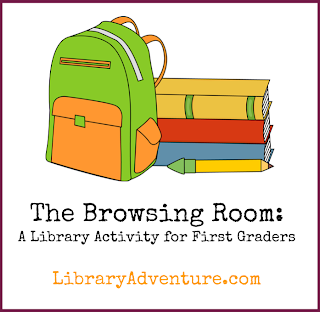If you use bounces in baby story time, you probably know this one:
Mother and Father and Uncle John
went to town one by one.
Mother fell off!
Father fell off!
But Uncle John...
went on and on and on and on and on and on!
(If you're not familiar with it, you can see the ladies from JBrary perform it
here.)
Today's Flannel Friday post will show you how you can share this same rhyme with an older (preschool) audience using the flannel board.
Though the rhyme doesn't explicitly say how the family is traveling to town, it's pretty likely to involve a horse, so you can begin with Mother, Father, Uncle John, and their horse on the flannel board. (The people in this photo are clipart images from kizclub.com and the horse can be found
here. The "flannel board" is actually just a piece of felt stapled to a file folder, which is all I had at home, but it does the job!)
To emphasize the rhythm of the rhyme, clap or tap as you say it and invite the kids to do the same. After saying the rhyme a couple of times to get everyone familiar with it, start to get the kids involved. Give each child a turn to name another way that Mother, Father, and Uncle John might travel to town. If you have a good assortment of transportation-themed flannel board pieces, the kids probably won't name anything you don't have on hand, but if you want to limit the selections a little bit, you could have them either choose from a pile, or give each child a piece on the way in to story time and call each child up to identify the one he or she was given when it's his or her turn.
Here are Mother, Father, and Uncle John riding some vehicles that typically fascinate three and four year olds: bulldozer, motorcycle, cement mixer, ambulance. Others would probably include school bus, pick-up truck, dump truck, garbage truck, and car.
To really personalize the kids' choices, and to add some variety to the rhyme itself and not just the visuals, you can also substitute the child's name into the rhyme and ask the child who he or she would like to ride with him or her. You might wind up changing the rhyme to "Sarah and Alice and Santa Claus..." or "Dylan and Aidan and Knuffle Bunny..." or any other number of fun combinations.
If you decide to provide options for the kids to choose from, or if you just want to end the presentation of the rhyme on a silly note, you can also bring out some unlikely choices. Below, Mother, Father and Uncle John travel by elephant and unicorn. If you're working with an animal theme, you could easily substitute other wild animals like a cheetah, giraffe, or zebra, for the elephant.
By adapting this rhyme for preschoolers, you provide them with opportunities to strengthen their transportation (or animal) vocabulary, to take an active part in the events of story time, and to share their own interests and preferences in an organized and controlled way.
Flannel Friday is hosted this week by Christine at
Felt Board Ideas. For more about Flannel Friday, visit the
official website.








.png)
.jpg)










.png)







